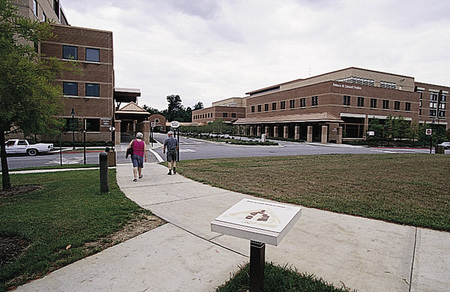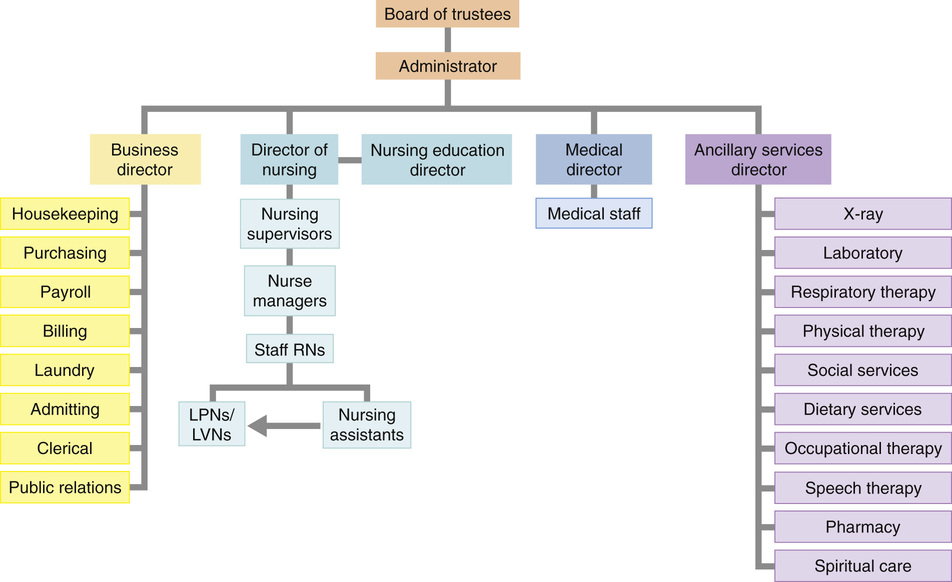Introduction to Health Care Agencies
Objectives
• Define the key terms and key abbreviations in this chapter.
• Describe the types, purposes, and organization of health care agencies.
• Describe the members of the health team and nursing team.
• Describe the nursing service department.
• Describe 5 nursing care patterns.
• Describe the programs that pay for health care.
• Explain your role in meeting standards.
• Explain how to promote PRIDE in the person, the family, and yourself.
Key Terms
Health care agencies (Box 1-1, p. 2) vary in size, services, hours open, and staff. The person is always the focus of care.
Staff members have special talents, knowledge, and skills. All work to meet the person’s needs.
Health care agencies must follow local, state, and federal laws and rules. This is to ensure safe care.
Agency Purposes
Services range from simple to complex. Some agencies have 1 purpose and offer 1 service. Surgery centers are an example. Surgeries and medical procedures are done in a non-hospital setting. The person returns home the same day or the next day. Other agencies have many purposes and services.
The purposes of health care are:
These purposes are related. For example: having chest pain, Mr. Parker goes to a hospital emergency room. After an exam and tests, the doctor diagnoses a heart attack. Mr. Parker is admitted to the hospital for treatment. He also receives teaching and counseling about heart attack risk factors, diet, drugs, life-style, activity, and coping with fears and concerns. He begins a rehabilitation program. Activity starts slowly and may progress from walking to jogging and swimming. Successful treatment and rehabilitation promote health and may prevent another heart attack.
Student Learning
Agencies are often learning sites for students. Students assist in the purposes of health care. They are involved with and provide care.
Types of Agencies
Nursing assistants work in many settings. Some work in doctors’ offices and clinics. Most work in the following agencies.
Hospitals
Hospitals provide emergency care, surgery, nursing care, x-ray procedures and treatments, and laboratory testing. They also provide respiratory, physical, occupational, speech, and other therapies. Hospital care is either in-patient or out-patient. In-patient care is health care a person receives when admitted to an agency such as a hospital or skilled nursing facility. See Figure 1-1. Out-patient (ambulatory) care includes medical or surgical care received when a person is not admitted to an agency.

People of all ages need hospital care. They have babies, surgery, physical and mental health disorders, and broken bones. Some are dying.
Hospital patients have acute, chronic, or terminal illnesses.
• Acute illness is a sudden illness from which the person is expected to recover . A heart attack is an example.
• Chronic illness is an on-going illness that is slow or gradual in onset. There is no known cure. The illness can be controlled and complications prevented with proper treatment . Diabetes is an example.
• Terminal illness is an illness or injury from which the person will not likely recover . The person will die (Chapter 55). Cancers not responding to treatment are examples.
Rehabilitation and Sub-Acute Care Agencies
Hospital stays are often short. Some people do not need hospital care but are too sick or disabled to go home. Care needs fall between hospital care and long-term care. Along with rehabilitation, complex equipment and care measures are needed. See Chapter 41 for common rehabilitation programs.
Some hospitals and long-term care centers have rehabilitation and sub-acute care units. Others are separate agencies. Many persons fully recover and return home. Others need long-term care.
Long-Term Care Centers
Some persons cannot care for themselves at home but do not need hospital care. Long-term care centers are designed to meet their needs. Care needs range from simple to complex. Medical, nursing, dietary, recreation, rehabilitation, and social services are provided. So are housekeeping and laundry services.
Persons in long-term care centers are called residents. They are not patients. The center is their temporary or permanent home.
Most residents are older. Many have chronic diseases, poor nutrition, memory problems, or poor health. Not all residents are old. Some are disabled from birth defects, accidents, or disease. Hospital patients are often discharged while still recovering from illness or surgery. Some need home care. Others need long-term care until able to go home. Others need care until death.
Skilled Nursing Facilities.
Skilled nursing facilities (SNFs) provide more complex care than do nursing centers. They are part of hospitals or nursing centers. SNF residents need rehabilitation or recovery time. Often they return home after a short stay. Others remain nursing center residents.
Assisted Living Residences
An assisted living residence (ALR) provides housing, personal care, support services, health care, and social activities in a home-like setting to persons needing help with daily activities (Chapter 53). Some ALRs are part of nursing centers or retirement communities (Chapter 12).
The person has a room or an apartment. Three meals a day and 24-hour supervision are provided. So are housekeeping, laundry, social, recreational, transportation, and some health care services. Help is given with personal care and drugs.
Mental Health Centers
Some persons have problems with life events. Others present dangers to themselves or others because of how they think and behave. Out-patient mental health care is common. Some need short-term or long-term in-patient care.
Home Care Agencies
Health care services are provided to people where they live. Services range from health teaching and supervision to bedside nursing care. Physical therapy, rehabilitation, and food services are common. Hospitals, health care systems, public health departments, and private businesses offer home care.
People of all ages need home health care. So do some persons who are dying.
Hospices
A hospice is a health care agency or program for persons who are dying. Such persons no longer respond to treatments aimed at cures. Usually they have less than 6 months to live.
The physical, emotional, social, and spiritual needs of the person and family are met. The focus is on comfort, not cure. Children and pets can visit. Family and friends can assist with care.
Hospice care is provided by hospitals, nursing centers, and home care and hospice agencies.
Health Care Systems
Agencies join together as 1 provider of care. A system usually has hospitals, nursing centers, home care agencies, hospice settings, and doctors’ offices (Fig. 1-2). An ambulance service and medical supply store for home care are common. The system serves a community or larger region.
The goal is to meet all health care needs. A person uses system providers as needed (Box 1-2, p. 4).
Organization
An agency has a governing body called the board of trustees or board of directors. The board makes policies. It makes sure that safe care is given at the lowest possible cost. Local, state, and federal laws are followed.
An administrator manages the agency. He or she reports directly to the board. Directors or department heads manage certain areas (Fig. 1-3, p. 4).
See Focus on Long-Term Care and Home Care: Organization, p. 4.





